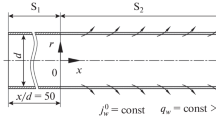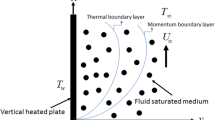Abstract
Using the differential turbulence model supplemented by the transport equation for the turbulent heat flux, a numerical study is carried out of the dependence of the Prandtl turbulent number on the molecular Prandtl number, the intensity of the gas injection (suction) through the permeable wall, and the freestream acceleration (deceleration). The air and mixtures of helium with xenon and argon are considered as gas carriers, and mercury, water, and transformer oil are used as liquid carriers. The obtained results of calculations are consistent with the available experimental data for the turbulent Prandtl number and the quantities included in its definition.
Similar content being viewed by others
References
W.M. Kays, Turbulent Prandtl number — where are we? Trans. ASME. J. Heat Transfer, 1994, Vol. 116, P. 284–295.
D.M. McEligot and M.F. Taylor, The turbulent Prandtl number in the near–wall region for low-Prandtl-number gas mixture, Int. J. Heat Mass Transfer, 1996, Vol. 39, P. 1287–1295.
L. Redjem-Saad, M. Ould-Rouiss, and G. Lauriat, Direct numerical simulation of turbulent heat transfer in pipe flows: effect of Prandtl number, Int. J. Heat Fluid Flow, 2007, Vol. 28, No. 5, P. 847–861.
H. Kawamura, K. Ohsaka, H. Abe, and K. Yamamoto, DNS of turbulent heat transfer in channel flow with low to medium-high Prandtl number fluid, Int. J. Heat Fluid Flow, 1998, Vol. 19, No. 5, P. 482–491.
H. Kawamura, H. Abe, and Y. Matsuo, DNS of turbulent heat transfer in channel flow with respect to Reynolds and Prandtl number effects, Int. J. Heat Fluid Flow, 1999, Vol. 20, No. 3, P. 196–207.
R.J. Moffat and W.M. Kays, A review of turbulent–boundary–layer heat transfer research at Stanford, 1958–1983, Advances Heat Transfer, 1984, Vol. 16, P. 241–365.
B.A. Kader and A.M. Yaglom, Heat and mass transfer laws for fully turbulent wall flows, Int. J. Heat Mass Transfer, 1972, Vol. 15, P. 2329–2351.
W.M. Kays, Convective heat and mass transfer. McGraw-Hill Education, 4th edition, 2004.
A.N. Gulyaev, V.E. Kozlov, and A.N. Sekundov, A universal one-equation model for turbulent viscosity, Fluid Dyn., 1993, Vol. 28, No. 4, P. 485–494.
V.C. Patel, W. Rodi, and G. Scheuerer, Turbulence models for near-wall and low Reynolds number flows: A review, AIAA J., 1986, Vol. 23, No. 9, P. 1308–1319.
K. Hanjalich and B.E. Launder, A Reynolds stress model of turbulence and its application to thin shear flows, J. Fluid Mech., 1972, Vol. 52, P. 609–638.
V.G. Lushchik, A.A. Pavel’ev, and A.E. Yakubenko, Three-parameter model of shear turbulence, Fluid Dyn., 1978, Vol. 13, No. 3, P. 350–360.
V.G. Lushchik, A.A. Pavel’ev, and A.E. Yakubenko, Three-parameter model of turbulence: Heat transfer calculations, Fluid Dyn., 1986, Vol. 21, No. 2, P. 200–211.
V.G. Lushchik, A.A. Pavel’ev, and A.E. Yakubenko, Transfer equation for turbulent heat flux. Calculation of heat exchange in a pipe, Fluid Dyn., 1988, Vol. 23, No. 6, P. 835–842.
A.A. Zhukauskas and A.A. Shlanchauskas, Heat Transfer in Turbulent Fluid Flow, Mintas, Vilnyus, 1973.
B.A. Kader and A.M. Yaglom, Similarity laws for near-wall turbulent flows, in: Itogi nauki i tekhniki. Ser. Mekhanika zhidkosti i gasa, VINITI, Moscow, 1980, Vol. 15, P. 81–155.
L.S. Kokorev, On a relation of the coefficients of turbulent exchange of heat and momentum in turbulent flow of liquid metal, in: Liquid Metals: Coll. Papers, Atomizdat, Moscow, 1963, P. 27–33.
P.I. Geshev, Turbulent heat transfer in a flow of liquid metal near the wall, J. Appl. Mech. Tech. Phys., 1975, Vol. 16, No. 6, P. 886–890.
R.J. Moffat and W.M. Kays, The turbulent boundary layer on a porous plate: experimental heat transfer with uniform blowing and suction, Int. J. Heat Mass Transfer, 1968, Vol. 11, No. 10, P. 1547–1550.
W.H. Thielbahr, W.M. Kays, and R.J. Moffat, The turbulent boundary layer — experimental heat transfer with blowing, suction, and favorable pressure gradient, Report No. HMT–5. Thermosciences Div. Dept. of Mech. Engineering, Stanford Univ., Stanford, CA, 1969.
A. Leont'ev, V. Lushchik, and M. Makarova, Heat and mass transfer in a tube with permeable walls: influence of suction and the Prandtl number, in: Proc. Eighth Int. Symp. on Turbulence, Heat and Mass Transfer, Saraevo, Bosnia and Herzegovina, September 15–18, 2015, Begell House Inc., USA, 2015, P. 145–148.
B.F. Blackwell, W.M. Kays, and R.J. Moffat, The turbulent boundary layer on a porous plate: An experimental study of the heat transfer behavior with adverse pressure gradients, Report No. HMT–16, Thermosciences Div. Dept. of Mech. Engng, Stanford Univ., Stanford, CA, 1972.
Author information
Authors and Affiliations
Corresponding author
Additional information
The work was financially supported by the Russian Science Foundation (Project No. 14-19-00499).
Rights and permissions
About this article
Cite this article
Lushchik, V., Makarova, M. Turbulent Prandtl number in the boundary layer on a plate: effect of the molecular Prandtl number, injection (suction), and longitudinal pressure gradient. Thermophys. Aeromech. 25, 169–182 (2018). https://doi.org/10.1134/S0869864318020026
Received:
Revised:
Published:
Issue Date:
DOI: https://doi.org/10.1134/S0869864318020026




